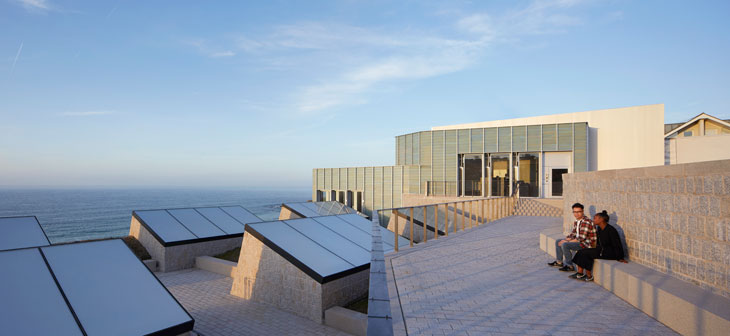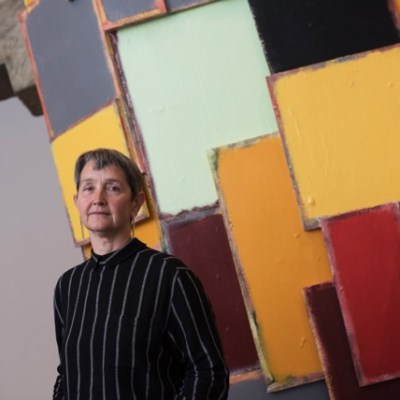Visitors to St Ives would be forgiven for overlooking the Tate gallery’s new extension. It is set into the hillside alongside the existing building and hidden behind an unremarkable block of flats, so there’s surprisingly little to announce its presence from the outside. Yet the opening of the 500-square-metre exhibition space this weekend marks a turning point for the gallery, after an 18-month closure, and the completion of a project that has been in the offing for more than a decade.
Tate’s farthest-flung outpost opened in 1993 on the site of an old gasworks overlooking Porthmeor beach. Designed by Eldred Evans and David Shalev, the building was intended to house the radical modernist works of 20th-century artists who lived or settled in the Cornish seaside town. The programme quickly expanded to include contemporary exhibitions, and the gallery became one of the region’s most popular attractions: it currently draws around 250,000 visitors per year. It was apparent as early as 2004 that the existing space simply wasn’t big enough to accommodate Tate St Ives’ audience or its ambitions. Yet, as its executive director Mark Osterfield remarked in a press conference this week, the solution has been a long time coming.
Tate St Ives by Jamie Fobert Architects. Photo © Hufton+Crow

Jamie Fobert’s original plan for a landmark building on the site of a nearby car park proved unpopular with the local community: as anyone who has tried to navigate the small town in a vehicle will know, parking spaces are at a premium. In response, the architect and Tate began a long series of public consultations and radically altered their designs. ‘We had discussions, some very robust,’ Osterfield says of the process, ‘but we’ve come up with a better project as a result.’ To excavate a gallery of this size from Cornwall’s hard Blue Elvin stone is no mean feat, but doing so has allowed Fobert to join the extension seamlessly with Tate St Ives’ existing rooms, while preserving public spaces – open tarmac included – on top.
The real transformation is on the inside, where alongside the development Tate staff have been coordinating a major refresh and rehang of the original building. The tall stairwell – previously something of a lost space – has been decorated with a mural by Glaswegian artist France-Lise McGurn, and the galleries themselves have been given over to a broadly chronological display that sets St Ives modernism and post-war art in its local and international context. Impressive works from the Tate collection are on display – some of them newly brought over from Tate’s London galleries – and the curator, Sarah Matson, has established some interesting visual comparisons.
Matisse’s Notre-Dame (c. 1900) is shown alongside Matthew Smith’s Cornish Church (1920), highlighting both artists’ counterintuitive use of red and pink hues to describe cold stone. An earthy, scratchy Dubuffet hangs next to Peter Lanyon’s tortuous homage to the men who mined the landscape around the Cornish town of St Just, painted in 1951. Old favourites such as Christopher Wood’s surreally unsettling Zebra and Parachute (1930) are back out of storage, and many of the St Ives works seem transformed in their new setting, within sight of the landscape and towns that inspired them.
‘Rebecca Warren: All That Heaven Allows’ at Tate St Ives, 2017. Photo: Maggie Gray

There are no views in the new gallery: ‘we have enough of those already,’ Osterfield quips. The cavernous space is laid out on a simple rectangular plan, and its most striking features are the slatted concrete ceiling and large skylights that amply illuminate the room. The space will serve as a venue for major temporary exhibitions, with British sculptor Rebecca Warren taking the inaugural slot: her lumpen, candy-coloured totems and Caro-esque steel sculptures adorned with pink pom-poms deliberately undercut the sombre post-war sculptures by the likes of Jean Fautrier and William Turnbull on display in the adjoining room. Warren’s feminist work fits Tate’s wider mission to give women artists a better showing, while the rest of the displays exhibit the same commitment to showing international, non-Western artists that Frances Morris has made a feature of her programming at Tate Modern. Among the artists shown in a gallery dedicated to post-war abstraction and politics are Gego, Lygia Clark, and Saloua Raouda Choucair.
Poem (1963–65), Saloua Raouda Choucair. © Saloua Raouda Choucair Foundation

Perhaps the most successful feature of the rehang is how deftly it ties international narratives together with local ones. Tate staff members have collaborated with the St Ives Archive Trust throughout the expansion project, and fascinating material from that and the Tate’s own holdings adds colour and character to the displays. Not far from a Mark Rothko canvas, for example, are two photographs of the painter and his wife, Mell, enjoying lunch at Kerris, near Penzance, with Terry Frost, Peter Lanyon, Marie Miles and the Feiler family. In a sense, the images epitomise the paradoxical character of St Ives and the Cornish peninsula, as a remote corner of the UK mainland with a long but often overlooked history of international trade and communication overseas.
Azalea Garden: May 1956 (1956), Patrick Heron. © The estate of Patrick Heron

Around 85 per cent of visitors to Tate St Ives currently hail from outside Cornwall. That is something Mark Osterfield hopes will change with the introduction of a locals’ pass offering repeat visits to the gallery and the nearby Hepworth Museum and Sculpture Garden for just £5 a year. (A regular combined ticket to these venues will set you back £14.50, or £13 without a Gift Aid donation; Tate St Ives is the only one of the Tate galleries to charge for entry.) But artistic director Anne Barlow is confident that the programme, and not just the price, will draw locals in. She plans to expand the gallery’s activities to include performance, multimedia art, residency programmes, research projects and on-site events to entice people from all walks of life.
Next spring, however, the gallery will return to its roots with a major retrospective dedicated to Patrick Heron, a British painter who lived and worked in nearby Zennor, and whose exuberant stained glass window greets visitors in the lobby. Until now, it has been impossible to display his large-scale canvases within Tate St Ives – but with the extension finally open, the gallery can finally think big.
Tate St Ives reopens to the public on 14 October.



